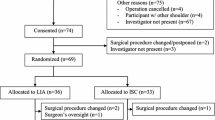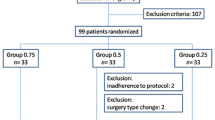Abstract
Introduction
Interscalene brachial plexus block (ISB) is widely used as an adjuvant regional pain therapy in patients undergoing major shoulder surgery and has proved its effectiveness on postoperative pain reduction and opioid-sparing effect.
Method
This single-center, prospective, double-blind, randomized and placebo-controlled study was to compare the effectiveness of a single-shot and a patient-controlled catheter insertion ISB system after major open-shoulder surgeries. Seventy patients were entered to receive an ISB and a patient-controlled interscalene catheter. The catheter was inserted under ultrasound guidance. Patients were then assigned to receive one of two different postoperative infusions, either 0.2% ropivacaine (catheter group) or normal saline solution (single-shot group) via a disposable patient-controlled infusion pump.
Results
The study variables were amount of rescue medication, pain at rest and during physiotherapy, patient satisfaction and incidence of unwanted side effects. The ropivacaine group revealed significantly less consumption of rescue medication within the first 24 h after surgery. Incidence of side effects did not differ between the two groups.
Conclusion
Based on our results, we recommend the use of interscalene plexus block in combination with a patient-controlled catheter system under ultrasound guidance only for the first 24 h after major open-shoulder surgery.





Similar content being viewed by others
References
Tuominen M, Pitkanen M, Rosenberg PH (1987) Postoperative pain relief and bupivacaine plasma levels during continuous interscalene brachial plexus block. Acta Anaesthesiol Scand 31:276–278
Wilson AT, Nicholson E, Burton L et al (2004) Analgesia for day-case shoulder surgery. Br J Anaesth 92:414–415
Borgeat A, Ekatodramis G (2002) Anaesthesia for shoulder surgery. Best Pract Res Clin Anaesthesiol 16:211–225
Borgeat A, Schappi B, Biasca N et al (1997) Patient-controlled analgesia after major shoulder surgery: patient-controlled interscalene analgesia versus patient-controlled analgesia. Anesthesiology 87:1343–1347
Lehtipalo S, Koskinen LO, Johansson G et al (1999) Continuous interscalene brachial plexus block for postoperative analgesia following shoulder surgery. Acta Anaesthesiol Scand 43:258–264
Winnie AP (1970) Interscalene brachial plexus block. Anesth Analg 49:455–466
Borgeat A, Tewes E, Biasca N et al (1998) Patient-controlled interscalene analgesia with ropivacaine after major shoulder surgery: PCIA vs. PCA. Br J Anaesth 81:603–605
Kapral S, Greher M, Huber G et al (2008) Ultrasonographic guidance improves the success rate of interscalene brachial plexus blockade. Reg Anesth Pain Med 33:253–258
Ootaki C, Hayashi H, Amano M (2000) Ultrasound-guided infraclavicular brachial plexus block: an alternative technique to anatomical landmark-guided approaches. Reg Anesth Pain Med 25:600–604
Blaivas M, Lyon M (2006) Ultrasound-guided interscalene block for shoulder dislocation reduction in the ED. Am J Emerg Med 24:293–296
Oderda GM, Evans RS, Lloyd J et al (2003) Cost of opioid-related adverse drug events in surgical patients. J Pain Symptom Manag 25:276–283
Philip BK, Reese PR, Burch SP (2002) The economic impact of opioids on postoperative pain management. J Clin Anesth 14:354–364
Kehlet H (1994) Painless and risk-free surgery—a vision of the future? Ugeskr Laeger 156:3468–3469
White PF (2007) Multimodal pain management—the future is now!. Curr Opin Investig Drugs 8:517–518
Kaiser H, Niesel HC, Hans V et al (1990) The function of peripheral nerve stimulators in the implementation of nerve and plexus blocks. Reg Anaesth 13:172–178
Bryan NA, Swenson JD, Greis PE et al (2007) Indwelling interscalene catheter use in an outpatient setting for shoulder surgery: technique, efficacy, and complications. J Shoulder Elbow Surg 16:388–395
Schwemmer U, Greim CA, Boehm TD et al (2004) Pain management in shoulder surgery. Schmerz 18:475–480
Klein SM, Grant SA, Greengrass RA et al (2000) Interscalene brachial plexus block with a continuous catheter insertion system and a disposable infusion pump. Anesth Analg 91:1473–1478
Klein SM, Nielsen KC, Martin A et al (2001) Interscalene brachial plexus block with continuous intraarticular infusion of ropivacaine. Anesth Analg 93:601–605
Grant SA, Nielsen KC, Greengrass RA et al (2001) Continuous peripheral nerve block for ambulatory surgery. Reg Anesth Pain Med 26:209–214
Ilfeld BM, Morey TE, Wright TW et al (2003) Continuous interscalene brachial plexus block for postoperative pain control at home: a randomized, double-blinded, placebo-controlled study. Anesth Analg 96:1089–1095 (table of contents)
Singelyn FJ, Seguy S, Gouverneur JM (1999) Interscalene brachial plexus analgesia after open shoulder surgery: continuous versus patient-controlled infusion. Anesth Analg 89:1216–1220
Kean J, Wigderowitz CA, Coventry DM (2006) Continuous interscalene infusion and single injection using levobupivacaine for analgesia after surgery of the shoulder. A double-blind, randomised controlled trial. J Bone Jt Surg Br 88:1173–1177
Capdevila X, Pirat P, Bringuier S et al (2005) Continuous peripheral nerve blocks in hospital wards after orthopedic surgery: a multicenter prospective analysis of the quality of postoperative analgesia and complications in 1,416 patients. Anesthesiology 103:1035–1045
Popping DM, Zahn PK, Van Aken HK et al (2008) Effectiveness and safety of postoperative pain management: a survey of 18,925 consecutive patients between 1998 and 2006 (2nd revision): a database analysis of prospectively raised data. Br J Anaesth 101:832–840
Capdevila X, Jaber S, Pesonen P et al (2008) Acute neck cellulitis and mediastinitis complicating a continuous interscalene block. Anesth Analg 107:1419–1421
Weber SC, Jain R (2002) Scalene regional anesthesia for shoulder surgery in a community setting: an assessment of risk. J Bone Jt Surg Am 84-A:775–779
Ekatodramis G, Borgeat A, Huledal G et al (2003) Continuous interscalene analgesia with ropivacaine 2 mg/ml after major shoulder surgery. Anesthesiology 98:143–150
Author information
Authors and Affiliations
Corresponding author
Rights and permissions
About this article
Cite this article
Goebel, S., Stehle, J., Schwemmer, U. et al. Interscalene brachial plexus block for open-shoulder surgery: a randomized, double-blind, placebo-controlled trial between single-shot anesthesia and patient-controlled catheter system. Arch Orthop Trauma Surg 130, 533–540 (2010). https://doi.org/10.1007/s00402-009-0985-7
Received:
Published:
Issue Date:
DOI: https://doi.org/10.1007/s00402-009-0985-7




